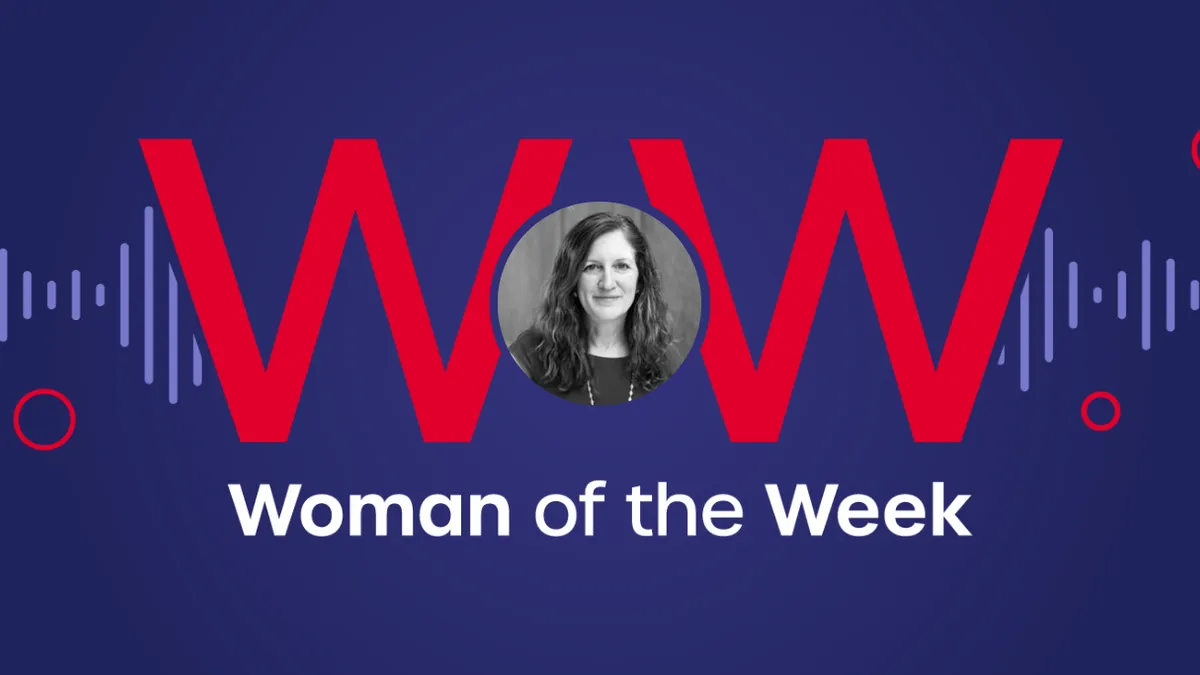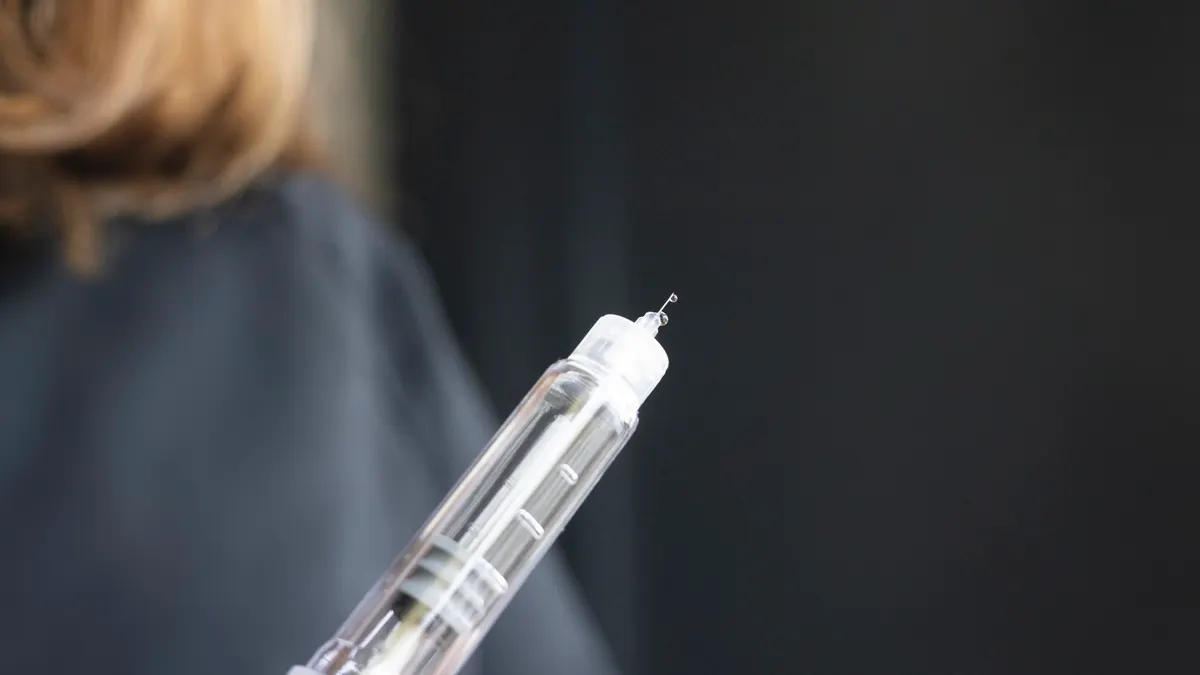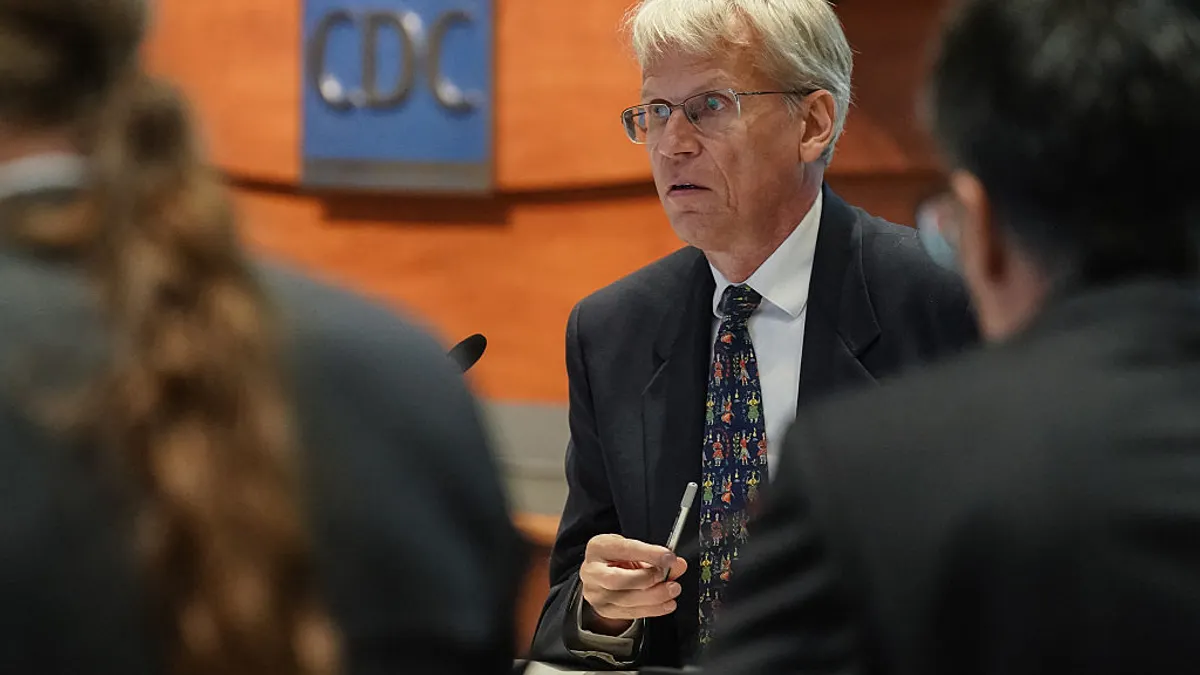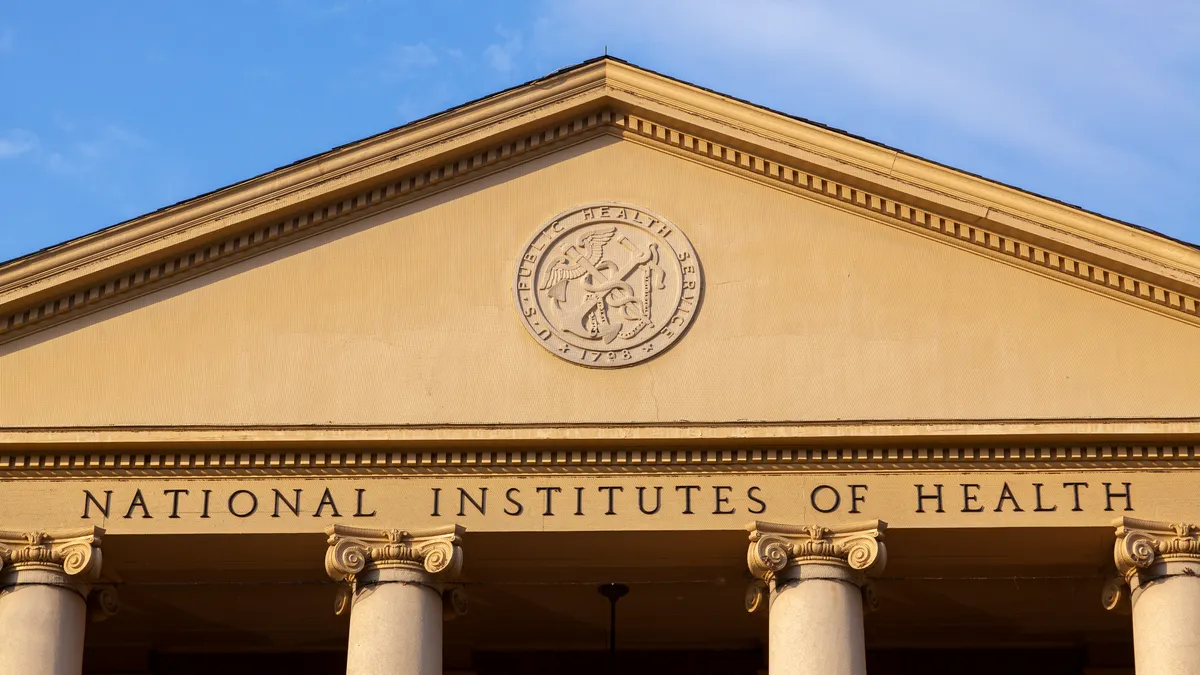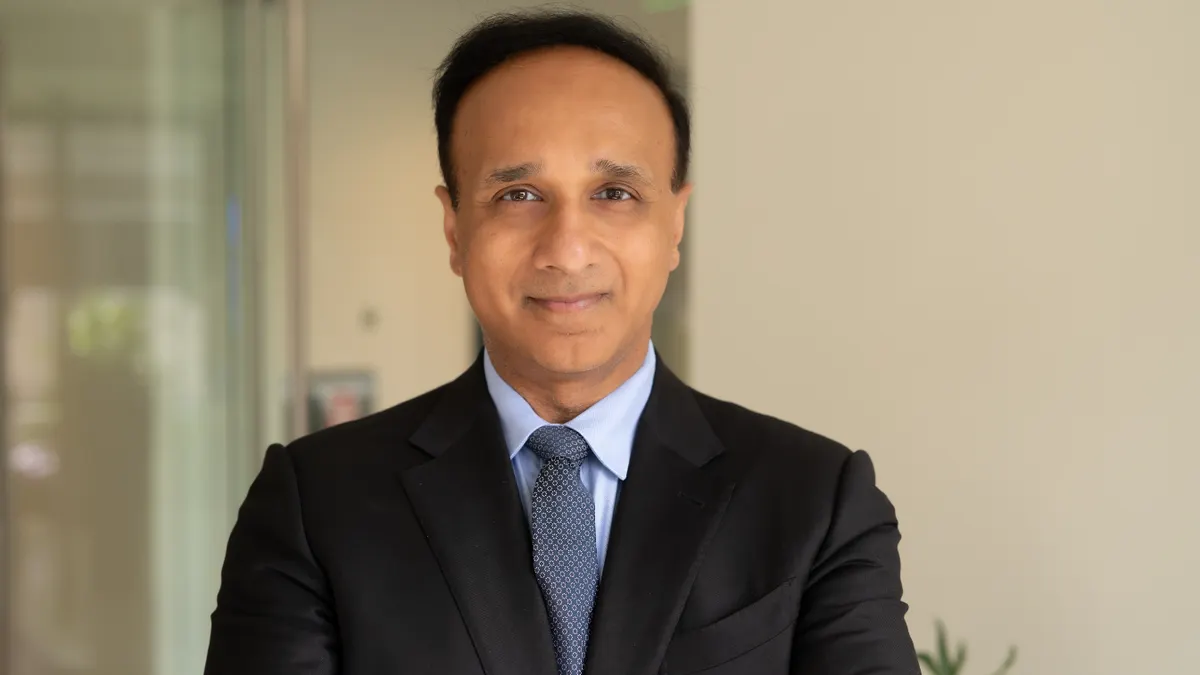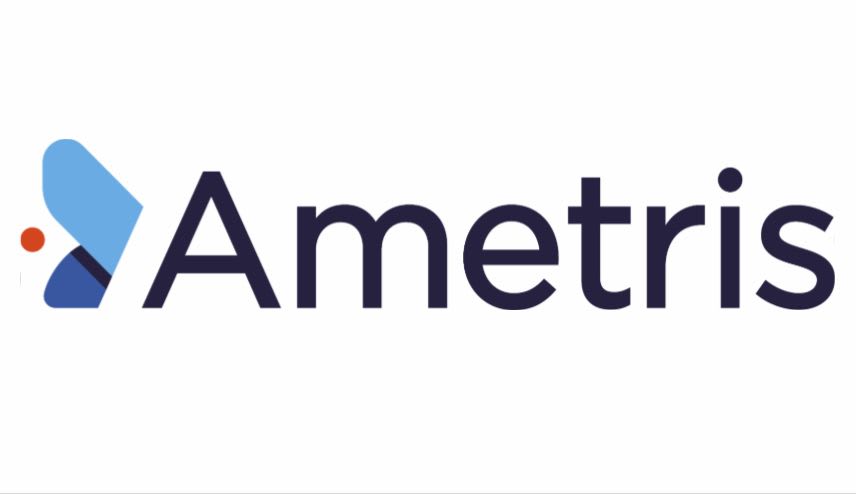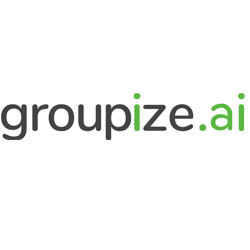Welcome to the Woman of the Week podcast, a weekly discussion that illuminates the unique stories of women leaders who are catalyzing change throughout the life sciences industry. You can check out all our podcast episodes here.
Reenie McCarthy’s role as CEO at Stealth BioTherapeutics was supposed to be temporary. Now, 13 years later, she says leading the mitochondrial biology company has been one of the most challenging yet rewarding experiences of her career.
McCarthy came to Stealth through Morningside Venture Capital, which had been running the biotech in a “quasi-virtual manner.”
“When the commitment was made in 2014 to build out the team to bring elamipretide, our lead compound, forward across a broad clinical proof of concept program, I stepped in on an interim basis to lead the team and it just clicked,” she said. “Preclinically across multiple disease models, elamipretide has shown benefit in neurodegeneration, cardiac and ophthalmic — understanding how to translate that in the clinic to see end-organ benefit for patients has been a journey.”
In 2023, McCarthy expects to submit an NDA for elamipretide in patients with Barth syndrome, an ultra-rare genetic disease that affects mostly children under 5 — fewer than 150 people in the U.S. and 250 people worldwide are diagnosed with the disease. Beyond Barth syndrome, the company is looking to complete enrollment in a phase 3 clinical trial for primary mitochondrial myopathy, which will read out next year.
“Another goal is to plan our future development strategy for dry age-related macular degeneration based on the exciting signals that we saw in a phase 2 clinical trial,” she said. “We’re also planning clinical trials that we hope to start in 2024 and in 2025, with elamipretide in new indications and with our pipeline compounds.”
McCarthy said the focus on Barth syndrome was driven in part by a patient advocacy group that approached Stealth back in 2014 based on data around the “lock and key mechanism” of the drug.
“It’s not a decision that you make lightly going into an ultra-rare disease, but we partnered with advocacy from the outset,” she said. “They’ve been beside us throughout the development journey, including extensive interactions with the FDA. It’s been a tremendous and rewarding partnership in many ways when we think about patient-focused drug development and our mission as a biotech company and (my mission) as a biotech CEO.”
Getting elamipretide to a fast track designation was not without bumps in the road and required McCarthy to dig deep and stay the course after receiving disappointing data from an early-stage trial.
“We did not see the results we wanted to in a small, probably too-short phase 2 clinical trial, but we were hearing and seeing significant changes in the data in open-label extension,” McCarthy said. “We leaned in as a team and made a commitment to keep going in that disease, which is core to our mission as a company, our moral compass and defines in many ways the enthusiasm of our team and commitment to patients.”
Here, McCarthy talks about how she and her team navigated a complex regulatory pathway, why her commitment to the patient community is based on transparency and trust and how being a life-long learner has been critical to her success.
Welcome to WoW, the Woman of the Week podcast by PharmaVoice powered by Industry Dive.
In this episode, Taren Grom, editor in chief emeritus at PharmaVoice, meets with Reenie McCarthy, CEO, Stealth BioTherapeutics.
Taren: Reenie, welcome to the WoW podcast program.
Reenie: Thank you so much for having me. I really look forward to our conversation.
Taren: Me too. Tell me about Stealth Biotherapeutics’ rare disease drug for Barth syndrome, and how are you working with patient advocacy groups to move the therapeutic forward?
Reenie: Thanks for that question. So Barth syndrome is an ultra-rare genetic disease. It affects less than 150 people in the US and less than 250 people worldwide. Our drug is called elamipretide. And so for Barth syndrome, the genetic defect essentially results in a deficit of a phospholipid called cardiolipin, which is essential for mitochondrial structure and function. With that, 85% of affected children die by the age of 5; and if they survive early childhood they do suffer from significant skeletal muscle weakness, exercise intolerance and fatigue, and cardiac dysfunction. And most of the deaths in the disease do come from cardiac dysfunction. And again, even those children who survive early childhood in all cases lead a shortened life. So our drug elamipretide is a mitochondrial targeted drug which is actually targeting cardiolipin.
We were literally approached by patient advocacy in 2014 and asked to consider development efforts given sort of the lock and key mechanism of our drug for this disease. It’s not a decision that you make lightly going into an ultra-rare disease, but we partnered with advocacy from the outset, doing some preclinical work and then moving into clinical trials. They’ve really been beside us throughout the development journey including with extensive interactions with the FDA. So it’s been a tremendous and really rewarding partnership in many ways when we think about patient focused drug development and the mission as a biotech company and a biotech CEO. I think that’s been one of our most rewarding relationships.
Taren: It’s so unusual. I don’t know that I’ve heard that story before where a patient advocacy group has approached a company to develop a drug. How do they even know about this compound?
Reenie: With research. So this was a mitochondrial targeted drug that we had in license in 2006 from Cornell University. And the mechanism was widely published, and the mechanism again was to target cardiolipin which is the cause of the genetic disease in Barth syndrome. Interestingly, it was both Barth patient advocacy and then separately that same year a researcher, Hilary Vernon at Johns Hopkins, separately approached us. She runs one of only two Barth syndrome multidisciplinary clinics in the world. And so it was interesting because it was a two-pronged approach coming in from both the doctor that treats many of these patients and from the advocacy group itself.
Taren: That’s amazing. What an inspiring story. So being in that ultra-rare disease space, especially as a CEO and in a biotech, what are some of those challenges that you face particularly as we are looking at such a volatile market environment right now?
Reenie: It’s been incredibly challenging. We do have other programs in slightly more common rare diseases as well as in dry age-related macular degeneration, which is a large common disease, but the Barth syndrome program in particular has brought many challenges along with many rewards. I’ve been asked by investors multiple times actually whether it’s worth our time to continue our development efforts. When you have such a rare disease, you only have one shot on goal in the clinic or you may only have one shot on goal in the clinic. We have literally screened and enrolled in our first clinical trial all of the eligible and willing patients in the US we believe. And so with that, if you don’t generate the evidence that is sufficient from a regulatory perspective, you have to try to find creative paths forward.
And that’s where I think some investor skepticism comes in Wall Street’s sort of rule of thumb is that if a rare disease affects less than 10,000 patients for a drug or less than a thousand for a biologic, it may not be investible. So for us having made this commitment to the patient community and running into some regulatory challenges definitely impacted us in the market as a public company. We’re lucky. We have a long-term, very supportive investor who believes in the science and took us private last year; and that really is giving us the time, hopefully, to get this development program across the line. I think because we were patient with it we were seeing really transformational changes being reported by patients and their doctor and their caregivers. And so we were patient and we kept trying to generate more data in this disease in open-label extension, doing natural history control trials. With that longer term treatment, we saw a very significant greater than 40% improvement in cardiac function, which actually is hopefully going to allow us to turn the regulatory corner towards approval.
Taren: Congratulations, that’s great.
Reenie: Thank you.
Taren: There’s a lot to unpack there so I want to get in to the rest of the pipeline in a minute, but I want to know what that process was like for you all to go from public to private. It’s tricky, right?
Reenie: It’s tricky. Again, we had an investor that owned more than 60% of our stock as a public company, and they were very supportive; and so for us, it was certainly tricky. It’s about a four- to six-month process and as you can imagine there’s teams and teams of lawyers involved. But it really did allow us to focus in more closely once we were on the other side of that on our development efforts. Being a public company, as you know, brings with it significant reporting requirements, there’s significant costs of being a public company. And so it’s really a relief to be on the other side of that in this window that we have here again to focus towards getting our first couple of approvals across the line.
Taren: Let’s dig into that. So in addition to your elamipretide.
Reenie: Some people say elam.
Taren: I’ll go with elam, thank you. What else about the pipeline excites you? You talked about macular degeneration.
Reenie: Yeah. So mitochondria, as you know, are in all of our cells and make all of our energy, right? And so when you think about the organ systems that are most dependent on mitochondrial energy, the eye is right up there, the brain, the heart, the skeletal and muscle system. And so mitochondrial pathology certainly presents in rare genetic diseases like Barth syndrome, but also many diseases of aging and dry age-related macular degeneration is one of those. We conducted a phase 1 clinical trial in dry AMD and we saw signs of improved visual function in patients. And then we essentially brought the program into a phase 2 clinical trial where we saw signs of improvement in vision so more patients gained two or more lines of vision on our drug certainly than in the placebo group and that was significant. But interestingly, we also saw improvement in photoreceptor function and that’s an imaging biomarker. So you take a scan, an OCT scan, of the retina and you can measure what’s called the ellipsoid zone of the photoreceptors, which are responsible for vision. And we saw that elamipretide was significantly protective of that photoreceptor function.
So it’s super exciting because if you know the dry AMD space, it’s the leading cause of blindness for elderly patients in the Western world; it’s a progressive disease. And we have our first approval this year with Syfovre; but so far while that’s slowing some of the atrophy associated with the disease, there haven’t been signs of improvement in vision for patients. We think with our approach, we are seeing that improved visual function and it may give us a path to intervene earlier in the disease trajectory so it is quite exciting.
Taren: That’s very exciting. So certainly diseases of the eye and mitochondrial, they’re really hot right now. Do you think that gives you all an advantage because you’ve been working in this space for so long?
Reenie: I think the advantage really comes from the lessons that we’ve learned over the years. Pre-clinically across multiple disease models, elamipretide has shown benefit in models of neurodegeneration, in models of cardiac disease, in models of ophthalmic disease to your point, but really understanding how to translate that in the clinic to see end-organ benefit for patients; that’s been a journey. We’ve been studying this a long time and I think that we’ve started to triangulate in on how long we need to conduct clinical trials for what patients we should be selecting, at what point in a disease trajectory can we intervene with this approach.
And so I do think that those lessons are important and I think they position us well, particularly as we start to bring forward new compounds. So we do have a pipeline behind elamipretide and we’re starting to bring those compounds into the clinic or into pre-IND enabling studies. And all of our learnings with elamipretide will hopefully expedite development of those pipeline compounds as well.
Taren: Are those pipeline compounds based on the same platform as elam?
Reenie: It’s a mix. So we do have some compounds that we’ve optimized for like distribution characteristics. Elamipretide doesn’t get into the brain in therapeutic concentrations, and we know that many neurodegenerative diseases are driven by mitochondrial dysfunction. So our lead pipeline compound is called SBT-272. We do see higher concentrations in both the brain and in the retina. But we have another series of pipeline compounds that actually have dual pharmacology and, and really differentiated mechanistically.
Taren: Excellent. Well thank you so much for sharing that, and it sounds like it’s exciting there. How big is the company right now?
Reenie: We have just under 45 employees.
Taren: You guys are doing a lot of work for 45 employees; that’s crazy. That’s a big pipeline you have too.
Reenie: It is. I think that we’re all very, very passionate about the promise of this approach to treating human disease, and it’s just so exciting. So I think we all maybe do a little bit more lifting because of our enthusiasm than you might otherwise expect.
Taren: That’s wonderful. When we talk about rare and ultra-rare diseases so often they’re on that cutting edge of innovation. And you talked earlier about working with regulators. How do you manage those conversations and those discussions? Because sometimes regulators aren’t as up to speed on some of the breakthrough technology and science. Is there an education process there for you all?
Reenie: It’s a huge education process, I would say, particularly in the ultra-rare disease setting. So you need to educate on the disease itself; and certainly for ultra-rare diseases, they’re not as well understood as more common diseases that have been extensively studied. You need to educate on the mechanism of action of the drug, which takes a long time sometimes. We’ve even had to educate extensively on just how rare Barth syndrome is. Barth syndrome patient advocacy has literally met with the FDA half a dozen times outside of joining us in our regulatory interactions to try to educate about the disease burden and again just how rare the disease is.
Taren: Wow. Well, again, that’s a lot of work and it’s a lot of dedication, a lot of passion. And talking about those patient advocacy groups, I know you have a very particular perspective on working with those groups and you talked about it a little earlier on with Barth’s disease; but tell me about how you manage those discussions and how you manage those relationships with those patient advocacy groups.
Reenie: So for any rare disease, it’s really crucial and likely as well for common diseases, but particularly for rare diseases it’s very crucial to partner early and often with patient advocacy. That relationship is important because it can help inform you what kinds of endpoints matter most to patients. It can help you when you’re thinking about clinical trial enrollment, when you’re thinking about what investigators are familiar with the patient population, and can act as sites for your trial. It can help you in regulatory interactions. We’ve developed two different disease-specific, patient-reported outcome measures, one for Barth syndrome, one for a disease called primary mitochondrial myopathy, and partnered closely with patient advocacy in developing both of those.
Based on our learnings from the Barth syndrome program, we’ve done early assessments of the potential of elamipretide to address the cardiac dysfunction which remains a high unmet need and Duchenne muscular dystrophy. And there again most of our early education and learnings come straight from patient advocacy. So that partnership is incredibly important. I would say in the ultra-rare setting, I think for us it’s also been really important to be pretty transparent and upfront with patient advocacy about what we can and what we cannot do as a company. And so building that relationship of trust and transparency, it’s also just really critical.
Taren: Yes, exactly. It’s a hard truth to have to tell and you’re dealing with those families who just have no options. So what an incredibly rewarding but very poignant like space you’re in.
Reenie: It is. It is. I think in the setting of Barth syndrome, again, there in particular and you can tell it’s pretty close to our mission as a company, we felt like we had made a commitment to the patient community that if we saw signals in a trial that we would try to work towards getting patients access to the drug. And we did see signals but not quite what we would’ve needed for an easy regulatory path. And when you start hearing reports of transformational benefit from families or from doctors like that, I think as a company we felt that we really had a moral commitment to proceed but to your point really needed to be upfront with advocacy about just how far we could take it or what kind of investment we would be able to make as a company. And, you’re right, it’s been incredibly rewarding but it’s also one of the things that’s probably kept me up most at night.
Taren: I would imagine; you’re dealing with the littlest of humans. And I know rare disease really affects children more than it does adults, but sometimes really heartbreaking because you get to know those patients because there just aren’t that many of them, right?
Reenie: Yes. It can be heartbreaking.
Taren: Okay. We’ll move on from that. You’ve been at the company for about 13 years. You transitioned in from a VC company, I understand, that had been supporting the company. Tell me about what drew you to take the helm of Stealth?
Reenie: So I was supposed to be the interim CEO and here I am 13 years later. We had been running Stealth in a quasi-virtual manner and a commitment was made in around 2014 to really build out the team and drive forward to broad clinical proof of concept. I stepped in again on an interim basis to lead the team and it just kind of clicked. So here I am, and it’s been a very rewarding experience but probably also one of the most challenging learning experiences of my life.
Taren: I was going to say now it’s some time in so you’re over all those learning curves. You said the patients are one of the things that keeps you up most at night as a CEO; what else occupies your strategy to-do list? What are your goals for 2023?
Reenie: So in 2023, we are expecting to submit our NDA for Barth syndrome and we are looking forward to completing enrollment in a phase 3 clinical trial in primary mitochondrial myopathy which will read out next year. Another goal really is to plan our future development strategy for dry age-related macular degeneration based on again the exciting signals that we saw in a phase 2 clinical trial and tee up some of our new compounds for the clinic. So we do have many goals for this year. I think that what we really like to do is look to the future. We’re also planning for clinical trials that we might be starting in 2024 and in 2025, both with elamipretide in new indications and then again with our pipeline compounds.
Taren: Okay. So it’s a busy year coming up, excellent. Let’s talk about your transition’; like I said, you were at a VC company before that, before taking on the CEO role at Stealth. How did you get into the VC company and tell me what initially drew you to the life sciences?
Reenie: So I joined the VC company in 1993. It’s Morningside and it was really a general VC investment group at that time, although the primary interest is on the life science side. So we were looking at investments also in technology, some real estate, but again primarily early-stage life sciences. This group is willing to invest early, invest in company building, and has a long-term outlook, really looking for transformational opportunities in terms of new science with huge potential. So that’s kind of the hallmark of the group Morningside. Again, I joined in 1993 and I think the life sciences piece was just fascinating from a learning perspective because the scope was pretty broad. Morningside doesn’t pigeonhole into any particular therapeutic area, probably more therapeutics than devices, but there were also some device investments. And so as somebody who really likes to learn, I think it was really fascinating from a learning perspective and also being able to partner with management teams and towards company building.
Taren: Excellent. Well thank you for that, I appreciate it. I see a lot of women now more so than in recent history taking on the C-suite and CEO role at these biotech companies, which is fantastic because it means now that there are folks like you sitting in role model spots. Do you consider yourself to be a role model?
Reenie: I’ve had a lot of role models in my life and so I know that role models can have a significant impact on people’s careers. I certainly like to partner with my team, to brainstorm with my team, and I hope in doing that I can help my team make good decisions, so I try to lead by example in that way.
Taren: You didn’t answer my question, but I’ll let you off the hook. Just so you know, I was paying attention there. I know it’s hard to ascribe to be a role model for oneself, but at the same time I think it’s important for women like you to accept that mantle because you have others who are looking up to you, and especially we still know that women are underrepresented at the highest level. So own it is my unsolicited advice to you. How would you describe your leadership strengths?
Reenie: So one of the things I really value and it’s part of the reason I didn’t really answer your last question, I tend to have a fairly flat organizational mentality, so I really value having great dialogue around the table. We hire very smart people in the biotech industry, there are various smart people, and I like to listen and learn from them. So one of the things I strongly value from a leadership perspective is that collaboration, that transparency with the team, that recognition that across the organization every individual, particularly in a small company like ours, is playing an important role contributing to the organization. So having that transparency and communication across the team I think helps to make us cohesive.
Taren: Fair enough. What are some of the biggest leadership lessons you have learned along the way? You said you started off in this job as an interim CEO and there was a bit of a learning curve there. Anything stand out for you?
Reenie: A few things. For me, there was a big learning curve and I think that I really benefited from a highly collaborative senior management team that was willing to answer my questions. Being willing to ask questions, being willing to own what your strengths and your weaknesses are so that you can learn from that I think is important from a leadership perspective. The other thing that I think again is really important is avoiding the siloing that can sometimes happen in companies between different functional areas. So breaking down some of those barriers again and making sure that you drive towards a more collaborative approach in leadership.
Taren: Very good. A minute ago when I asked you about the role model question, you said you’ve had a lot of role models. Is there anybody who’s had a particular influence on your career?
Reenie: Yes. So at Morningside I worked closely with the co-founder of the Morningside group who’s Gerald Chan. And if you don’t know him, he’s somebody who’s been a lifelong learner which actually mimics early lessons from my parents in terms of the importance of learning. And many of my earliest conversations with him from when I first joined the group were “Are you having fun? Are you interested? Are you engaged? Are you learning?” And I think that that’s just been from a role model perspective. It’s one of the things I value most because learning is important and it helps us move forward and always being willing to view situations in a fresh light.
Taren: I love that. And you talked about your parents, like tell me about that. What influence have they had on you?
Reenie: My mom was a very strong woman. I can remember her doing everything from painting the house to certainly beating all of us at card games and word puzzles, so that was a really important influence. She would leave me notes that I would have to pull out dictionaries to decode what the words meant. So very strong leadership influence from my mom in my life. And my dad was a lifelong learner. He was watching videos to refresh himself on calculus so he could understand string theory when he was in his 80s. So again I think that strong commitment to learning really came from them.
Taren: Wow, that’s impressive. So tell me, how do you embody that lifelong learning? What are some of the things that you do?
Reenie: I have three children so we always learn from our children. And on the business and scientific side, I would say that being in mitochondrial science, frankly because of the many, many potential diseases that can be touched by that, it’s a constant learning journey. We’re always learning about new therapeutic areas and how our compounds could fit into them as well as the industry as a whole.
Taren: Fantastic. One question I didn’t ask you earlier about the company was the name, Stealth Biotherapeutics. Is it because you all were working just under the radar or was it because you were uncovering these stealthy kind of compounds?
Reenie: It was more of the latter. Like mechanistically, the mitochondria have been an incredibly challenging therapeutic target. It’s hard to get to the mitochondria because it’s a double-membraned organelle sitting behind a cell membrane. Our compounds actually diffuse through the membranes largely because they have a positive-negative charge motif, which essentially masks going through the membranes. And that’s really where the name came from, was that unique mechanism of targeting mitochondria.
Taren: Thanks for that. That science is really fascinating. No wonder you’re all in on this. Tell me what is the one thing that most people don’t know about you?
Reenie: So I started as a lawyer. I’m not sure that that’s a big secret but it’s a long time ago. I studied law and practiced for about five years before joining Morningside. And I think that’s really contributed to my business skills as well as analytical thinking skills.
Taren: That’s awesome. You don’t want to mess with the CEO who’s also a lawyer. It gives you a whole different perspective. Do you consider yourself to be a mentor?
Reenie: Well I’m not going to make the mistake of not answering that question directly. I think, yes, I do. I like to take time and engage with my team and have multiple one-on-ones with folks. But I do think mentorship is a two-way street, so I think to the extent I mentor people with my experience, I’m generally learning just as much from them.
Taren: Fantastic. Sitting in that CEO suite and especially for a smaller company, must be lonely sometimes at the top. Who do you rely on for guidance, for advice?
Reenie: Again, I’m really blessed with a strong and highly collaborative senior management team. So I think my colleagues on the clinical side, on the commercial side, on the legal side that are sitting on that management team with us, we talk very, very frequently, multiple times a day often if there’s questions that are coming up. And so we really do lead together as a team so it doesn’t actually feel all that lonely in our company.
Taren: Very good. We are nearing the end of our time together so I’m going to ask you what is that WoW moment that either changed the trajectory of your career or has left a lasting impression on you?
Reenie: I’m going to go back to Barth syndrome because again it’s an ultra-rare disease where we did not see the results we wanted to in a small, probably too-short phase 2 clinical trial, but we were hearing and seeing significant changes in the data in open-label extension. And when we leaned in as a team and made a commitment to try to keep going in that disease, it’s kind of core to our mission as a company, it’s core to I think our commitment to patients and our moral compass as a company; and it’s defining in many ways the enthusiasm of our team and commitment to patients.
Taren: Thank you, Reenie, for that. I appreciate that. Let me ask you about when you had to make that decision and you said “No, we are going to go forward.” What did that mean? Did you have to go back to the drawing board? What happened there?
Reenie: We embarked upon a regulatory odyssey that has brought us through four different divisions of the FDA. We conducted a phase 3 natural history control trial so that’s additional investment, although we couldn’t enroll new patients in a double-blind placebo control trial. That phase 3 natural history control trial was a significant commitment by us. We continued to treat patients in open-label extension and we’ve recently partnered the program so that we can hopefully progress towards European regulatory approvals on the basis of the data we have.
Taren: Well, congratulations on your perseverance, and I wish you continued success and moving forward and being able to help these patients who are in such desperate need of a treatment. Thank you for your time today. I really appreciate it, Reenie.
Reenie: Thanks, Taren. Nice to speak with you.
Thanks for listening to this episode of WoW, the Woman of the Week podcast. For more WoW episodes, visit pharmavoice.com.


 Podcast
Podcast

